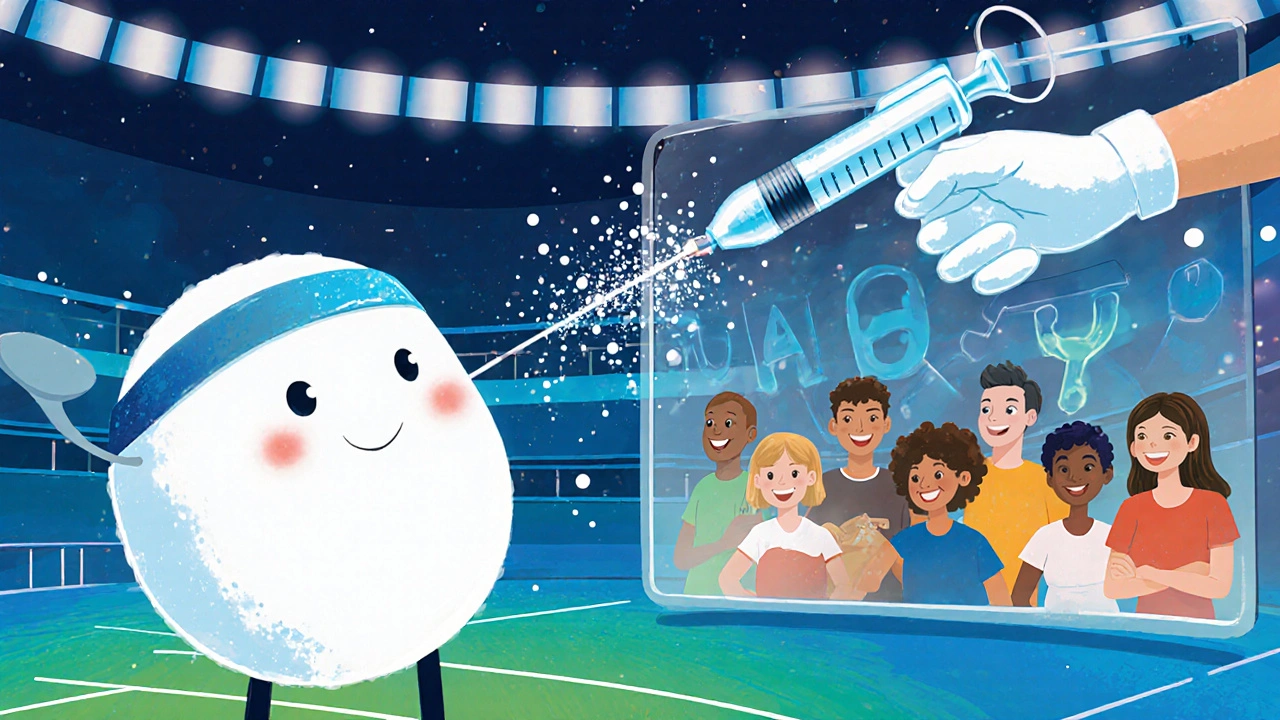Flu Vaccine Effectiveness Estimator
This tool estimates your approximate flu vaccine effectiveness based on your age group and health status. Results are based on general population data and may vary.
Quick Take
- The flu vaccine trains your body to recognize the virus before you encounter it.
- There are three main types: inactivated, live‑attenuated, and recombinant.
- Production starts months before flu season and uses the most likely strains.
- Getting vaccinated protects you, your loved ones, and helps keep hospitals from being overwhelmed.
- Side effects are usually mild-like a sore arm-and far less risky than flu complications.
When talking about seasonal protection, flu vaccine is a biological preparation that induces immunity against influenza viruses by presenting harmless fragments of the virus to the immune system. Understanding the science behind it makes the decision to get the shot feel less like a routine chore and more like a smart health move.
How the Flu Vaccine Triggers Immunity
The key players in the protection game are the virus’s surface proteins-hemagglutinin (HA) and neuraminidase (NA). When you receive a flu vaccine, you’re exposed to these proteins without the virus’s ability to cause disease. Your body’s immune system a network of cells, tissues, and organs that detects and eliminates foreign invaders sees the HA and NA fragments as a threat.
Specialized white blood cells called B‑cells start producing antibodies Y‑shaped proteins that lock onto specific parts of a pathogen, neutralising it. These antibodies linger in the bloodstream, ready to recognise the real flu virus if it ever shows up. If the virus tries to enter a cell, the antibodies block HA from attaching, stopping infection before it starts.
At the same time, T‑cells learn to spot infected cells and destroy them, adding another layer of defence. The whole process creates an “immunological memory” that can react faster and stronger than a first‑time encounter.
Different Flavors of Flu Vaccines
Not all flu vaccines are created equal, but they all aim to present HA and NA to the immune system. Below is a quick side‑by‑side look.
| Type | Administration | Typical Age Range | Composition | Average Effectiveness |
|---|---|---|---|---|
| Inactivated (IIV) | Injection | 6 months+ | Killed virus grown in eggs or cells | 40‑60% (depends on strain match) |
| Live‑Attenuated (LAIV) | Nasal spray | 2‑49 years (not for pregnant or immunocompromised) | Weakened virus that can’t cause disease | ~50% (higher in children) |
| Recombinant (RIV) | Injection | 18+ | HA protein produced in insect cells, no egg proteins | 55‑70% (good when egg‑based match is poor) |
Each format has its pros. Inactivated shots are the most widely used and safe for almost everyone. Nasal spray mimics a natural infection, which is why it works well for kids. Recombinant vaccines avoid egg‑related allergies and can be produced faster when a new strain emerges.

From Lab to Arm: How Vaccines Are Made
The manufacturing pipeline starts with the World Health Organization (WHO) and national bodies like the CDC picking the three (or four) strains most likely to circulate. Those strains become the blueprint for the vaccine.
Traditionally, the selected viruses are injected into fertilised chicken eggs, where they multiply over 48‑72hours. The fluid is harvested, the virus is inactivated (if it’s an IIV), and the HA/NA proteins are purified. Modern cell‑based factories use mammalian or insect cells instead of eggs, shaving days off the process and reducing the risk of egg‑adapted mutations.
Recombinant technology skips the whole virus step. Scientists insert the gene for HA into a baculovirus, which then infects insect cells that churn out the HA protein. The protein is harvested, purified, and formulated with stabilisers and, sometimes, an adjuvant a substance that boosts the immune response, allowing a smaller dose to work.
Why Getting the Flu Vaccine Matters
Beyond personal protection, vaccination creates a community shield known as herd immunity the indirect protection that occurs when a high percentage of a population is immune, slowing the spread of disease. Even if the vaccine isn’t a perfect match, it can still reduce the severity of illness, lowering hospital stays and the risk of complications like pneumonia or heart attacks.
Every year, the flu claims thousands of lives in Australia alone, particularly among the elderly and those with chronic conditions. A simple shot cuts the risk of flu‑related hospitalisation by about half. For working adults, the benefit also includes fewer sick days and less disruption to families.
Addressing Common Concerns
“It can give me the flu.” The inactivated vaccine contains dead virus particles that can’t replicate. The live‑attenuated spray uses a weakened strain that isn’t strong enough to cause illness in healthy people. Most side effects are limited to soreness, mild fever, or a brief runny nose.
“I’m healthy, so I don’t need it.” Even healthy individuals can experience severe flu complications, and they can unknowingly pass the virus to vulnerable loved ones. Vaccination reduces the overall virus load in the community, making outbreaks less intense.
“I’m allergic to eggs.” Recombinant vaccines contain no egg protein, and many manufacturers now offer egg‑free alternatives for those with severe allergies.
“Why every year? Isn’t the virus the same?” Influenza viruses mutate constantly-an effect called antigenic drift. Each season’s dominant strains shift enough that yesterday’s vaccine loses its punch, so the WHO updates the formulation annually.
Quick Checklist Before Your Appointment
- Know which vaccine type you prefer (injection vs nasal spray).
- Check for egg‑allergy concerns; ask about recombinant options.
- Bring a list of current medications-some antiviral drugs can interfere with vaccine response.
- Plan for a short rest afterward if you’re prone to mild fever.
- Schedule your shot before the local flu season peaks (usually May‑October in Australia).

Frequently Asked Questions
Can the flu vaccine protect against COVID‑19?
No. The flu vaccine targets influenza viruses only. COVID‑19 needs its own specific vaccines. However, getting a flu shot can free up medical resources for COVID‑19 patients.
How long does immunity last after vaccination?
Immunity peaks about two weeks after the shot and wanes over the flu season. That’s why the vaccine is given annually.
Is it safe for pregnant women?
Yes. The inactivated flu vaccine is recommended for pregnant people during any trimester. It protects both mother and baby during the first six months after birth.
Do children need a flu shot every year?
Children older than six months should get vaccinated annually. Those under nine who are getting their first flu vaccine need two doses spaced at least four weeks apart.
What if I miss the start of flu season?
A late‑season shot still offers protection. Flu viruses circulate for months, so vaccinating even in June or July can reduce your risk of illness.


Author
Mike Clayton
As a pharmaceutical expert, I am passionate about researching and developing new medications to improve people's lives. With my extensive knowledge in the field, I enjoy writing articles and sharing insights on various diseases and their treatments. My goal is to educate the public on the importance of understanding the medications they take and how they can contribute to their overall well-being. I am constantly striving to stay up-to-date with the latest advancements in pharmaceuticals and share that knowledge with others. Through my writing, I hope to bridge the gap between science and the general public, making complex topics more accessible and easy to understand.